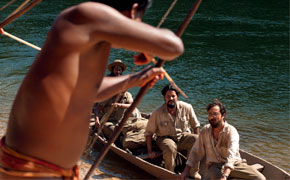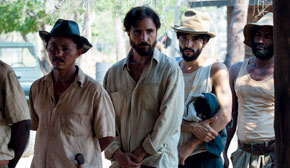 BEATRIZ LEFÈVRE
BEATRIZ LEFÈVREThe Villas-Bôas brothers make their first contact with the nativesBEATRIZ LEFÈVRE
The Xingu is a land of rivers. The rivers are the highways that cross the enormous territory of the Amazon Region. In Cao Hamburger’s film, the river is the distance that the Villas-Bôas brothers must cross to establish the first friendly contact with a tribe of indigenous people. It is no surprise that water runs through the letters in the credits for Xingu, but in the opinion of critic Jean-Claude Bernardet, the fluidity of the film goes far beyond rivers, stemming, according to him, from the harmony among the film’s various levels: plot, decoupage, filming and film editing. “The constant movement of the camera provides a lightness to the narrative that is rarely seen in Brazilian films,” he says. This perception contrasts with Hamburger’s previous films, such as O ano em que meus pais saíram de férias [The year in which my parents went on vacation]. “Xingu has made a major contribution, one that is worthy of having filmmakers think about.”
The theme of the film is powerful: it describes the Brazilian government’s effort to populate the country’s north and west regions, remote areas previously populated by native Brazilians. According to Chris Riera, who collaborated with the team of scriptwriters, Xingu shows the invasion of the Amazon Region by the white man. The Villas-Bôas brothers’ mission was to ensure that the invasion would be conducted as peacefully as possible. Bernardet laments that critiques of the film were limited to this story. He feels that this was not enough: “There is no meaning without significance.” The construction of the significance is of interest to this researcher of motion picture language and led him to contact Cao Hamburger and to schedule a conversation with him.
“I wanted a camera that could come closer to the actors and that would be more stable,” explains the film director. This is why he chose equipment that differs from the shoulder-supported camera that he had used in his other films. A hand-held camera makes the image somewhat shaky and provides a documentary aspect to a motion picture. This time, Hamburger decided to use a steadicam. The operator using a steadicam wears a harness attached to an elastic arm, and the camera has a stabilizing system. This is why viewers have the impression that the camera is floating through the scene, observing the events as if the action were not unraveling for the camera. This is a distinctly different view, perhaps a partial consequence of filming in a very different environment from the usual ones. “I had never filmed without a door, window, chair, car, glass…” says Hamburger, who, in his quest to understand the experience of being away from these urban points of reference, decided to spend his vacation in isolated places and watched all the motion pictures with outdoor scenes that he was able to find.
The way the film director builds up the scenes also adds to this feeling of fluidity. Based on the script and on the perception of the film in his mind, he held rehearsals immediately prior to shooting a scene. This was when he and his team decided what position each actor would be in for a given scene. These dynamics created a collective work, whereby actors, camera operators and all the other people involved participated in the creation, contributing their ideas, perceptions and emotions.
 BEATRIZ LEFÈVRE
BEATRIZ LEFÈVRECláudio and Leonardo enlist in the expeditionBEATRIZ LEFÈVRE
Most importantly, the scenes are all acted out from beginning to end – including the parts that are not filmed. An example of this kind of unplanned shooting is seen at the beginning of the film, when Cláudio and Leonardo Villas-Bôas enlist in the expedition to explore remote regions of Brazil. The line is long and each person says his name, educational level, and qualifications to an inspector sitting at a table and writing notes. “The actor who plays the inspector only appears during a short take, when he looks up at Cláudio, but that actor played the entire scene,” says the director. The scene goes on, as indicated by the names being called out, while the brothers move away, celebrating their achievement, as the camera follows them – a technique that connects the moments and the areas of the action, leading the spectator as if though he were sailing down the Xingu River in a canoe. “Even something that is not filmed is part of the scene and very often something outside the shot is better than what is inside,” Hamburger says. He is surprised by the comment on the consequences of this form of filming on the narrative; Bernardet was the first person to voice such a comment.
The film critic’s attention was attracted by the fact that fluidity was maintained even during major elliptical constructions, when not everything is explained. This differs quite significantly from a more conservative narrative in which a character going from one place to another has to be shown taking a taxi, getting inside, closing the door and arriving at his destination. “I like to leave some space for the viewer to think, to feel, and to create his own conclusions or passage,” says Hamburger. In addition, the film contained a major challenge: it had to cover a broad expanse of time and space. This is why the narrative had to leap forward. “I decided to leave some small gaps at various points for the spectator to feel the pace of the ellipses which would make big jumps possible,” he explains. In Bernardet’s opinion, this construction is so good that the ellipses does not cause the viewers to lose interest or become confused. They are not gaps. .“This narrative by allusion to scenes is a contribution to the Brazilian motion picture industry,” he states.
A subtle voiceover narration and the sound track that reinforces the emotions are other elements that were thought out and added to the script when the film was edited. These elements maintain the film’s fluidity and give the spectator information in a short, lighthearted manner.
Nevertheless, Xingu was not a major box-office success. Bernardet wonders whether the subtlety and elegance of the narrative did not satisfy a segment of the viewers. The director agrees that a blockbuster would need to be more explicit. However, he feels that many other obstacles in the way between the spectator and the motion picture played a more decisive role. “Brazilians really dislike Indians,” he says. To try to bring down this barrier, he decided not to show the natives as victims. He does not dwell on the natives’ complaints, even when contact with white men is destructive. It would have been necessary to make a completely different film to test the influence of the narrative language on box-office success. And that would be another film.
Republish